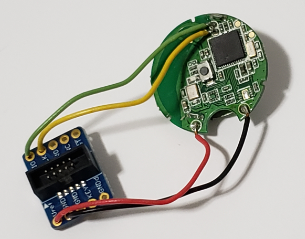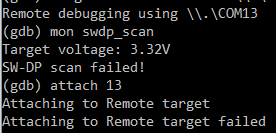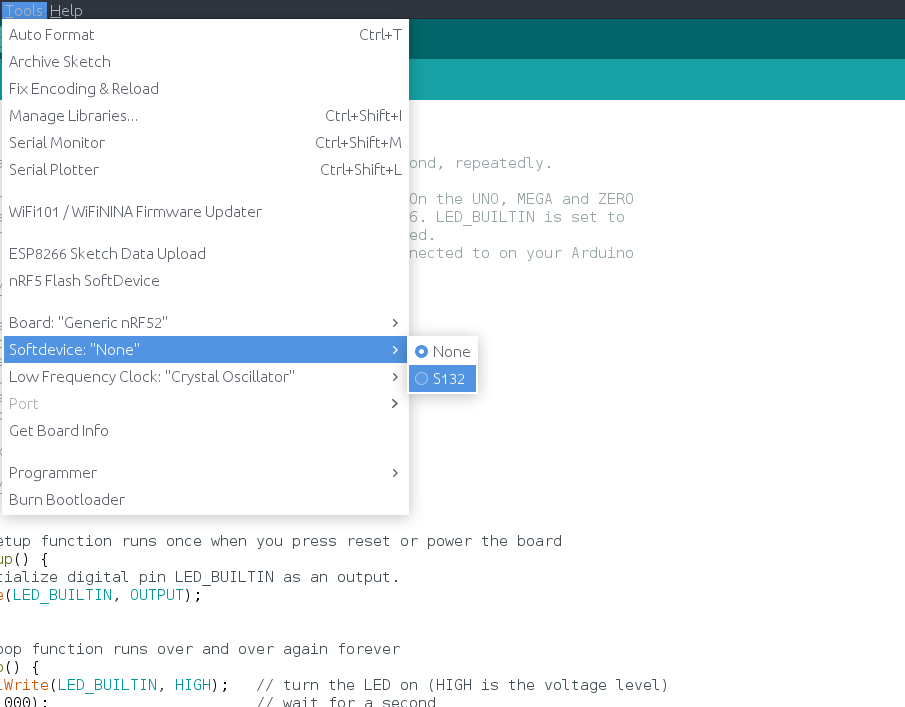GUIDE - NRF5 / NRF51 / NRF52 for beginners
-
@monte Could you please share the custom sleep function?
-
@monte Could you please share the custom sleep function?
@Puneit-Thukral you can start looking from here https://forum.mysensors.org/post/92044
-
Is it possible to use such a ready made device, and reprogram it with a mysensors sketch?
-
Is it possible to use such a ready made device, and reprogram it with a mysensors sketch?
@electrik yes. You will need an SWD programmer, J-link, ST-link or black magic probe will do. But the thing, you've linked isn't NRF5 device. So if you are asking about exactly that device, then answer is no. Only Nordic bluetooth devices are supported by mysensors. The one you've linked uses TI chip.
-
@electrik yes. You will need an SWD programmer, J-link, ST-link or black magic probe will do. But the thing, you've linked isn't NRF5 device. So if you are asking about exactly that device, then answer is no. Only Nordic bluetooth devices are supported by mysensors. The one you've linked uses TI chip.
@monte Thanks. I didn't notice it was not a Nordic one. So if I take such module, I just have to figure out the pins to program and it can be re-used.
Did you or someone else ever tried this? -
@monte Thanks. I didn't notice it was not a Nordic one. So if I take such module, I just have to figure out the pins to program and it can be re-used.
Did you or someone else ever tried this?Hi @electrik
You can program these ibeacons to work with MySensors.
I reprogrammed one by soldering some wires to a jlink adapter. Not elegant, but it worked.
Some type of push pin setup would be good if you are going to actually use these modules.
The version I got had only a button on the board, and no way to easily add any other sensors, so they weren't very useful. It would be interesting to try the ones with the temperature and acceleromator.
-
I am using a generic nRF52 dev board with the Arduino nRF52 core. I am trying to get a sample BLE service to display, but it cannot find it on my BLE scanner. After I couldn't get that to work, I decided to make the code even simpler. Since the dev board that I am using has a serial USB out I thought I would just check if I could get a "Hello World!" to the serial monitor... After flashing the soft device, I still couldn't get any output on my serial monitor.
Open On-Chip Debugger 0.10.0-dev-00254-g696fc0a (2016-04-10-10:13) Licensed under GNU GPL v2 For bug reports, read http://openocd.org/doc/doxygen/bugs.html debug_level: 0 0x4000 adapter speed: 10000 kHz nrf52.cpu: target state: halted target halted due to debug-request, current mode: Thread xPSR: 0x61000000 pc: 0x0001b08e msp: 0x20001188 nrf52.cpu: target state: halted target halted due to debug-request, current mode: Thread xPSR: 0x01000000 pc: 0xfffffffe msp: 0xfffffffc ** Programming Started ** auto erase enabled nrf52.cpu: target state: halted target halted due to breakpoint, current mode: Thread xPSR: 0x61000000 pc: 0x2000001e msp: 0xfffffffc wrote 114688 bytes from file C:\Users\Admin\Documents\ArduinoData\packages\sandeepmistry\hardware\nRF5\0.7.0/cores/nRF5/SDK/components/softdevice/s132/hex/s132_nrf52_2.0.1_softdevice.hex in 2.559271s (43.762 KiB/s) ** Programming Finished ** ** Verify Started ** nrf52.cpu: target state: halted target halted due to breakpoint, current mode: Thread xPSR: 0x61000000 pc: 0x2000002e msp: 0xfffffffc nrf52.cpu: target state: halted target halted due to breakpoint, current mode: Thread xPSR: 0x61000000 pc: 0x2000002e msp: 0xfffffffc verified 110636 bytes in 0.372659s (289.924 KiB/s) ** Verified OK ** ** Resetting Target ** shutdown command invokedI am using OpenOCD and an ST-Link v2 to upload my code and it looks like it is uploading successfully. Here is the output when I try to flash the S132 soft device:
void setup() { Serial.begin(9600); Serial.println("Starting..."); } void loop() { Serial.println("Hello World!"); delay(1000); }I also tried running this code with the MySensors library:
#define MY_RADIO_NRF5_ESB #include <MySensors.h> void setup() { Serial.begin(9600); Serial.println("Starting"); } void loop() { Serial.println("Hello World!"); delay(3000); }And got this error:
In file included from C:\Users\Admin\Documents\ArduinoData\packages\sandeepmistry\hardware\nRF5\0.7.0\cores\nRF5/Arduino.h:5:0, from sketch\MyBoardNRF5.ino.cpp:1: c:\users\admin\documents\arduinodata\packages\sandeepmistry\tools\gcc-arm-none-eabi\5_2-2015q4\lib\gcc\arm-none-eabi\5.2.1\include\stdint.h:9:26: fatal error: stdint.h: No such file or directory compilation terminated. exit status 1 Error compiling for board MyBoardNRF5 nRF52832. Error while flashing SoftDevice. java.io.FileNotFoundException: C:\Users\Admin\Documents\ArduinoData\packages\MySensors\hardware\nRF5\0.3.0\softdevices.txt (The system cannot find the file specified) -
I am using a generic nRF52 dev board with the Arduino nRF52 core. I am trying to get a sample BLE service to display, but it cannot find it on my BLE scanner. After I couldn't get that to work, I decided to make the code even simpler. Since the dev board that I am using has a serial USB out I thought I would just check if I could get a "Hello World!" to the serial monitor... After flashing the soft device, I still couldn't get any output on my serial monitor.
Open On-Chip Debugger 0.10.0-dev-00254-g696fc0a (2016-04-10-10:13) Licensed under GNU GPL v2 For bug reports, read http://openocd.org/doc/doxygen/bugs.html debug_level: 0 0x4000 adapter speed: 10000 kHz nrf52.cpu: target state: halted target halted due to debug-request, current mode: Thread xPSR: 0x61000000 pc: 0x0001b08e msp: 0x20001188 nrf52.cpu: target state: halted target halted due to debug-request, current mode: Thread xPSR: 0x01000000 pc: 0xfffffffe msp: 0xfffffffc ** Programming Started ** auto erase enabled nrf52.cpu: target state: halted target halted due to breakpoint, current mode: Thread xPSR: 0x61000000 pc: 0x2000001e msp: 0xfffffffc wrote 114688 bytes from file C:\Users\Admin\Documents\ArduinoData\packages\sandeepmistry\hardware\nRF5\0.7.0/cores/nRF5/SDK/components/softdevice/s132/hex/s132_nrf52_2.0.1_softdevice.hex in 2.559271s (43.762 KiB/s) ** Programming Finished ** ** Verify Started ** nrf52.cpu: target state: halted target halted due to breakpoint, current mode: Thread xPSR: 0x61000000 pc: 0x2000002e msp: 0xfffffffc nrf52.cpu: target state: halted target halted due to breakpoint, current mode: Thread xPSR: 0x61000000 pc: 0x2000002e msp: 0xfffffffc verified 110636 bytes in 0.372659s (289.924 KiB/s) ** Verified OK ** ** Resetting Target ** shutdown command invokedI am using OpenOCD and an ST-Link v2 to upload my code and it looks like it is uploading successfully. Here is the output when I try to flash the S132 soft device:
void setup() { Serial.begin(9600); Serial.println("Starting..."); } void loop() { Serial.println("Hello World!"); delay(1000); }I also tried running this code with the MySensors library:
#define MY_RADIO_NRF5_ESB #include <MySensors.h> void setup() { Serial.begin(9600); Serial.println("Starting"); } void loop() { Serial.println("Hello World!"); delay(3000); }And got this error:
In file included from C:\Users\Admin\Documents\ArduinoData\packages\sandeepmistry\hardware\nRF5\0.7.0\cores\nRF5/Arduino.h:5:0, from sketch\MyBoardNRF5.ino.cpp:1: c:\users\admin\documents\arduinodata\packages\sandeepmistry\tools\gcc-arm-none-eabi\5_2-2015q4\lib\gcc\arm-none-eabi\5.2.1\include\stdint.h:9:26: fatal error: stdint.h: No such file or directory compilation terminated. exit status 1 Error compiling for board MyBoardNRF5 nRF52832. Error while flashing SoftDevice. java.io.FileNotFoundException: C:\Users\Admin\Documents\ArduinoData\packages\MySensors\hardware\nRF5\0.3.0\softdevices.txt (The system cannot find the file specified)@abelson first you have to flash SD and then chose softdevice in board options and flash your sketch.
It seems that you are lacking softdevice binary. It seems that your version of sandeepmistry's NRF5 core is pretty outdated, you have 0.3 version when surrent version is 0.7. No wonder that links to softdevice binaries are broken insoftdevices.txt. Try updating core to the latest version and/or downloading softevice binary from nordic's site yourself. -
@abelson first you have to flash SD and then chose softdevice in board options and flash your sketch.
It seems that you are lacking softdevice binary. It seems that your version of sandeepmistry's NRF5 core is pretty outdated, you have 0.3 version when surrent version is 0.7. No wonder that links to softdevice binaries are broken insoftdevices.txt. Try updating core to the latest version and/or downloading softevice binary from nordic's site yourself. -
@monte that makes sense. Do you know what options I have to do to flash the sketch after I flash the soft device? If I get the above output that I posted, does that mean that the soft device flashed successfully?
-
@BearWithBeard said in GUIDE - NRF5 / NRF51 / NRF52 for beginners:
I just got my first NRF5 running. I'll note how I got it working in case any of you guys still have troubles:
Setup
- OS: Windows 10
- Programmer: STM32 Blue Pill with the Black Magic Probe firmware
- NRF5: EByte E73-TBB dev board with a E73-2G4M0S1B (NRF52832)
- Environment: PlatformIO
Instructions
Load the Black Magic Probe firmware with
stlinkas the probe host onto Blue Pill. You can follow this guide.Connect your new BMP to the NRF52 module:
BMP NRF52 Serial Port 3V3 3V3 GND GND A5 SWDCLK GDB Server B14 SWDIO GBD Server A2 TX UART A3 RX UART Note: A2 and A3 are not required for programming. This is how you'd wire up the BMP for "classic" serial debugging. You can use the BMP both for programming and serial communication - no need for a second FTDI module.
Using the GNU Arm Embedded Toolchain, run
arm-none-eabi-gdbin a console and enter the following commands to unlock the NRF52:target extended-remote BMP_GDB_SERVER_PORT mon swdp_scan attach N // N = number of "Nordic nRF52 Access Port" if there are several mon erase_mass detachFrom the two serial ports the BMP provides, you want to use the GDB Server for
BMP_GDB_SERVER_PORTabove. If Windows only provides generic names for both ("USB Serial Device" or something), the one with the lower number should (usually) be the right choice. If not, try the other one.Windows users also must prefix the port with
\\.\if the number is double-digit, e.g.\\.\COM13.Now you can start uploading sketches the usual way. Here's my minimal PlatformIO config:
[env:nrf52_dk] platform = nordicnrf52 board = nrf52_dk board_build.variant = generic framework = arduino upload_protocol = blackmagic lib_deps = 548 ; MySensorsAnd a minimal test sketch for MySensors:
#include <Arduino.h> #define LED 17 #define MY_RADIO_RF24 #define MY_RADIO_NRF5_ESB #define MY_NODE_ID 182 #define SKETCH_NAME "NRF52 Test" #define SKETCH_VERSION "0.1" #include <MySensors.h> #define CHILD_ID 1 MyMessage msg(CHILD_ID, V_VAR1); void presentation() { sendSketchInfo(SKETCH_NAME, SKETCH_VERSION); present(CHILD_ID, S_CUSTOM); } void setup() { pinMode(LED, OUTPUT); } void loop() { static uint8_t num; send(msg.set(num)); ++num; digitalWrite(LED, HIGH); wait(5000); digitalWrite(LED, LOW); wait(5000); }Works like a charm so far! Now, if you please excuse me, I have a whole new microprocessor family to explore. Fun times!
For the life of me i cant figure out if im making the BlackMagic properly. I'm moving the boot0 jumper to 1, flashing the 8kb maple (usb flash) DFU file using the st-link application on windows.
I move the jumper back to 0, and connect using the micro usb, and i can flash code normally using arudino IDE using the STM32duino bootloader (and if i do so, i see the device communication on a new COM port).
From there i cant get anything from these guides to work. the windows STM "flash demonstrator" app doesnt recognize the device, and i dont have a linux machine available at the moment for the dfu-util (and Ubuntu shell on windows wont recognize the usb device). When i try to flash the blackmagic.bin starting at 0x08002000 using the ST-link software it shows it succeeded, but when i return the jumper to 0 and reset the device, this is what i get:

The 2 new COM ports appear (COM12,COM13), but i cant seem to flash anything successfully.
I've installed the GNU arm toolchain for windows and tried "target extended-remote \.\COM13" (12 just gets stuck on nothing), and i get:

-
I just got my first NRF5 running. I'll note how I got it working in case any of you guys still have troubles:
Setup
- OS: Windows 10
- Programmer: STM32 Blue Pill with the Black Magic Probe firmware
- NRF5: EByte E73-TBB dev board with a E73-2G4M0S1B (NRF52832)
- Environment: PlatformIO
Instructions
Load the Black Magic Probe firmware with
stlinkas the probe host onto Blue Pill. You can follow this guide.Connect your new BMP to the NRF52 module:
BMP NRF52 Serial Port 3V3 3V3 GND GND A5 SWDCLK GDB Server B14 SWDIO GBD Server A2 RXI UART A3 TXO UART Note: A2 and A3 are not required for programming. This is how you'd wire up the BMP for "classic" serial debugging. You can use the BMP both for programming and serial communication - no need for a second FTDI module.
Using the GNU Arm Embedded Toolchain, run
arm-none-eabi-gdbin a console and enter the following commands to unlock the NRF52:target extended-remote BMP_GDB_SERVER_PORT mon swdp_scan attach N // N = number of "Nordic nRF52 Access Port" if there are several mon erase_mass detachFrom the two serial ports the BMP provides, you want to use the GDB Server for
BMP_GDB_SERVER_PORTabove. If Windows only provides generic names for both ("USB Serial Device" or something), the one with the lower number should (usually) be the right choice. If not, try the other one.Windows users also must prefix the port with
\\.\if the number is double-digit, e.g.\\.\COM13.Now you can start uploading sketches the usual way. Here's my minimal PlatformIO config:
[env:nrf52_dk] platform = nordicnrf52 board = nrf52_dk board_build.variant = generic framework = arduino upload_protocol = blackmagic lib_deps = 548 ; MySensorsAnd a minimal test sketch for MySensors:
#include <Arduino.h> #define LED 17 #define MY_RADIO_RF24 #define MY_RADIO_NRF5_ESB #define MY_NODE_ID 182 #define SKETCH_NAME "NRF52 Test" #define SKETCH_VERSION "0.1" #include <MySensors.h> #define CHILD_ID 1 MyMessage msg(CHILD_ID, V_VAR1); void presentation() { sendSketchInfo(SKETCH_NAME, SKETCH_VERSION); present(CHILD_ID, S_CUSTOM); } void setup() { pinMode(LED, OUTPUT); } void loop() { static uint8_t num; send(msg.set(num)); ++num; digitalWrite(LED, HIGH); wait(5000); digitalWrite(LED, LOW); wait(5000); }Works like a charm so far! Now, if you please excuse me, I have a whole new microprocessor family to explore. Fun times!
@BearWithBeard
Great explanation, thanks!
On my windows 10 installation I had to run Zadig to make the programming from platformIO work. -
@BearWithBeard
What did you do to get the serial pins of the Ebyte development board configured correctly, when using the generic board variant in platformIO? I've copied MyBoardNRF5.cpp but this is not used it seems.
Also redefining the definitions from variant.h#define PIN_SERIAL_TX (11) #define PIN_SERIAL_RX (12)doesn't give serial output.
-
@BearWithBeard
What did you do to get the serial pins of the Ebyte development board configured correctly, when using the generic board variant in platformIO? I've copied MyBoardNRF5.cpp but this is not used it seems.
Also redefining the definitions from variant.h#define PIN_SERIAL_TX (11) #define PIN_SERIAL_RX (12)doesn't give serial output.
@electrik Yeah, I ran into that issue, too. Not sure if that's the proper way to solve it, but I add a custom board directory to the build flags in platformio.ini ...
build_flags = -I $PROJECT_DIR/boards/generic... and copied the board variant files from
.platformio/packages/framework-arduinonordicnrf5/variants/Generic/toboards/generic/in my project folder. Changes made in here aren't ignored or overwritten by global PIO definitions. -
@electrik Yeah, I ran into that issue, too. Not sure if that's the proper way to solve it, but I add a custom board directory to the build flags in platformio.ini ...
build_flags = -I $PROJECT_DIR/boards/generic... and copied the board variant files from
.platformio/packages/framework-arduinonordicnrf5/variants/Generic/toboards/generic/in my project folder. Changes made in here aren't ignored or overwritten by global PIO definitions.@BearWithBeard Thanks that did it.
Could it be the TX and RX are switched on the BMP in your post? -
@BearWithBeard Thanks that did it.
Could it be the TX and RX are switched on the BMP in your post?@electrik Good to hear. And yes, I think you are right. I'll swap them and change the naming to RXI and TXO to clarify the directionality. Thanks for the hint!
-
With respect to initial erase of NRF52, I have been using @BearWithBeard Black Magic Probe instructions successfully for years. But, my latest set of Minew boards doesn't respond.
I found that there is a new lock procedure from Nordic:I have tried upgrading my gdb and also J-Link EDU and nrfjprog tool chains and have not successfully connected to the new boards yet.
Has anyone had success with unlocking one of these new boards?
-
With respect to initial erase of NRF52, I have been using @BearWithBeard Black Magic Probe instructions successfully for years. But, my latest set of Minew boards doesn't respond.
I found that there is a new lock procedure from Nordic:I have tried upgrading my gdb and also J-Link EDU and nrfjprog tool chains and have not successfully connected to the new boards yet.
Has anyone had success with unlocking one of these new boards?
@nagelc Sorry I don't have an informed answer, but thanks for posting and making us aware of your experience with the minew's! Haven't heard from you in a while. Have you tried upgrading the firmware on the J-link that's part of a DK? I can't say that I have, but the firmware upgradeability was one of the alleged selling features of a DK's J-Link. That potential upgradeability didn't ever seem to matter, but maybe now it does.
As for me, after a long break I'm back to have a run at getting the nRF52805 to work. So far I've got bare metal blinking and bare metal UART working. I'm opting for bare metal code because it's unclear how well anything else will work with the nRF52805, which doesn't seem all that well supported. Soon to get some basic bare metal proprietary radio working, I hope.... If successful, I'll post it to github to memorialize it. There are surprisingly few examples of bare metal code out there, even though that's all the datasheet itself talks about. I guess I can understand why, because I've found some surprising ambiguities in the datasheet. For instance, who would have thought that PSELTXD would refer to an actual pin number and not to a bitmask? From the datasheet I thought for sure it would be a bitmask (like nearly everything else in the datasheet), but no, it's the actual pin number. I mean, why does the datasheet show literally every bit of a 32 bit word is relevant for specifying the pin number? On a different issue, bare metal UART doesn't work quite right without some artificial delays, even if driven by interrupt events, apparently because the actual generated baudrates aren't exactly right (something the datasheet admits). So, there's some finessing involved that you don't see when you're only working from abstracted libraries.
Regardless, the architecture itself remains pretty cool, and I enjoy it a lot!

